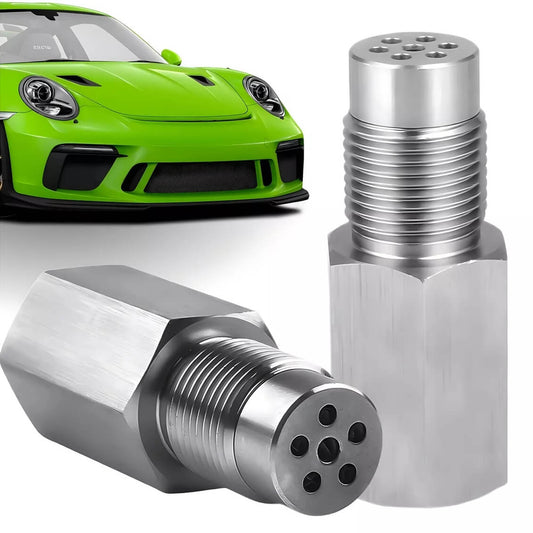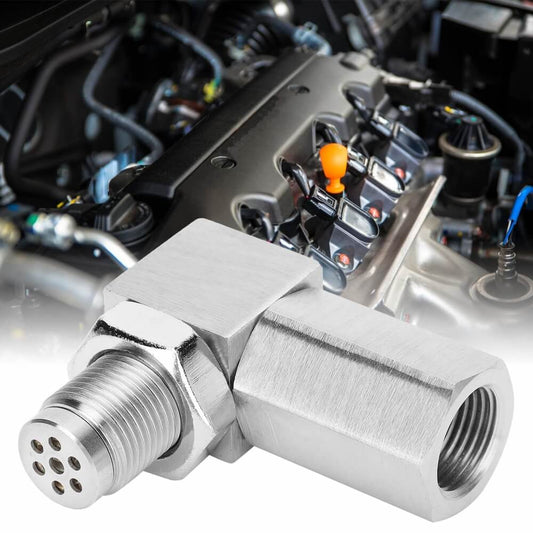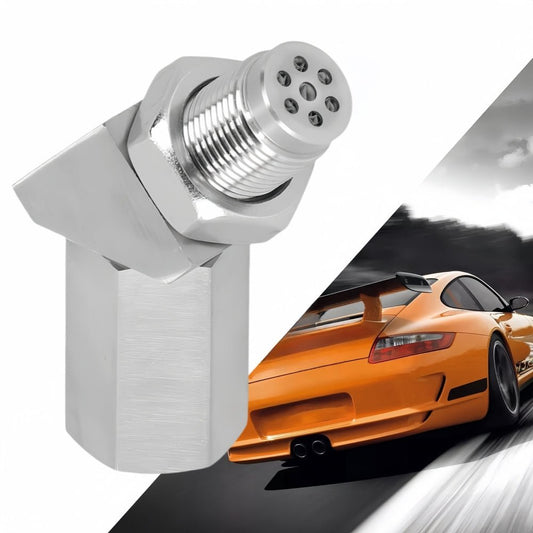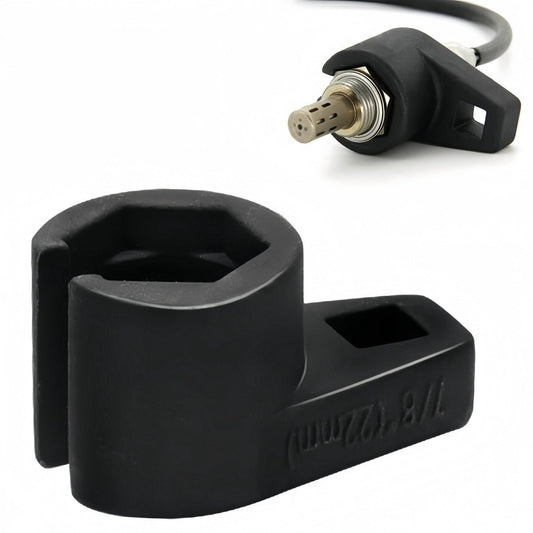Role of Mini Catalizador in Passing State Emissions Tests
Share
In the United States, many states require vehicles to undergo emissions tests to ensure their emission levels meet environmental standards, particularly in states like California and other regions with strict emissions regulations. For vehicles that have modified their exhaust systems (such as installing high-flow catalytic converters, removing factory catalytic converters, or using test pipes), the Check Engine Light (CEL) often comes on, especially due to erroneous readings from the post-oxygen sensor that trigger trouble codes like P0420 and P0430. These issues not only affect vehicle performance but can also cause the vehicle to fail the emissions test.

Mini Catalizador as an Emissions Compliance Tool
One of the design goals of the Mini Catalizador is to help vehicles pass emissions tests, especially those with modified exhaust systems. By simulating the function of a factory catalytic converter, the Mini Catalizador effectively addresses the emissions test failure issues caused by exhaust system modifications. Specifically, it "tricks" the vehicle's Electronic Control Unit (ECU) by using the built-in mini catalytic converter to make the ECU believe that a functional catalytic converter is still present in the exhaust system, preventing the CEL from triggering and ensuring the vehicle passes the emissions test.
How Mini Catalizador Helps Pass Emissions Tests
1. Simulating the Function of a Catalytic Converter
In modified exhaust systems (especially those with high-flow catalytic converters, removed catalytic converters, or test pipes), the post-oxygen sensor may detect abnormal exhaust flow and temperature changes, causing the ECU to mistakenly think the catalytic converter is damaged or nonfunctional, triggering the CEL. Mini Catalizador solves this issue by using a built-in mini catalytic converter to process the exhaust gases in a way similar to a traditional catalytic converter. The catalyst (such as platinum, palladium, and rhodium) converts harmful gases into harmless gases. Even though the post-oxygen sensor is not directly exposed to the high-temperature exhaust flow, it can still function properly and send the expected signals to the ECU. The ECU, therefore, "believes" the catalytic converter is still present and operating normally, eliminating any indications of exhaust system failure and preventing the CEL trouble codes.
2. Preventing P0420 and P0430 Trouble Codes
P0420 and P0430 are common trouble codes that indicate low efficiency or failure of the catalytic converter. For vehicles with modified exhaust systems, these codes are often triggered due to abnormal oxygen sensor readings. Mini Catalizador prevents these false codes by adjusting the position of the post-oxygen sensor and using the built-in catalytic converter to simulate the function of a traditional catalytic converter. This "trick" makes the vehicle's exhaust system appear to be functioning properly, thereby increasing the chances of passing the emissions test.
3. Compliance with Environmental Regulations
While Mini Catalizador is not a direct replacement for a traditional catalytic converter, it still effectively reduces vehicle emissions, particularly in high-flow exhaust systems or when the catalytic converter has been removed. The built-in mini catalytic converter can convert harmful nitrogen oxides (NOx), carbon monoxide (CO), and hydrocarbons (HC) into carbon dioxide (CO2) and water (H2O), helping vehicles reduce pollutants and meet emissions standards during testing. For vehicles with modified exhaust systems, the Mini Catalizador can help maintain emissions compliance and prevent failure in emissions tests due to excessive pollution.
Installation of Mini Catalizador and its Relation to Emissions Tests
For vehicles that need to pass an emissions test, installing a Mini Catalizador is a relatively simple solution that does not require welding or electrical modifications. The installation typically takes less than 10 minutes and does not require any special tools or skills. Once installed, the Mini Catalizador can effectively simulate the function of a traditional catalytic converter and eliminate the CEL caused by inaccurate oxygen sensor readings. Installing the Mini Catalizador before an emissions test can significantly reduce the risk of failing the emissions test.
Vehicles and Range Suitable for Emissions Tests
Mini Catalizador is compatible with most vehicles that feature an M18 x 1.5mm oxygen sensor interface, covering a range of engine sizes from 1.6L to 6.3L. It works with various vehicle brands, including BMW, Audi, Toyota, Nissan, Honda, and more. For vehicles with modified exhaust systems, whether turbocharged or naturally aspirated, the Mini Catalizador can help ensure that these vehicles pass the emissions test.
Mini Catalizador and State Emissions Regulations
Although the Mini Catalizador can help most vehicles pass emissions tests, in some states with stricter emissions laws (like California), certified catalytic converters may still be required for the vehicle to be street-legal. The Mini Catalizador is not equivalent to a legally approved replacement catalytic converter; it primarily addresses the emissions testing issues caused by high-flow exhaust systems or modified exhaust systems. In states with stringent regulations, vehicle owners are still advised to check local laws to ensure their exhaust system complies with all emissions requirements. If the goal is simply to pass an emissions test, the Mini Catalizador is an effective and practical solution.
Summary
Mini Catalizador is an efficient tool that helps vehicles with modified exhaust systems pass emissions tests. By simulating the function of a traditional catalytic converter, it effectively resolves the P0420 and P0430 trouble codes caused by exhaust system modifications, preventing the CEL from triggering and avoiding emissions test failure. While it is not a direct replacement for a traditional catalytic converter, in most cases, the Mini Catalizador can help vehicles pass emissions tests without affecting emissions standards. However, vehicle owners should still check the specific regulations in their state to ensure compliance.

Mini Catalizador as an Emissions Compliance Tool
One of the design goals of the Mini Catalizador is to help vehicles pass emissions tests, especially those with modified exhaust systems. By simulating the function of a factory catalytic converter, the Mini Catalizador effectively addresses the emissions test failure issues caused by exhaust system modifications. Specifically, it "tricks" the vehicle's Electronic Control Unit (ECU) by using the built-in mini catalytic converter to make the ECU believe that a functional catalytic converter is still present in the exhaust system, preventing the CEL from triggering and ensuring the vehicle passes the emissions test.
How Mini Catalizador Helps Pass Emissions Tests
1. Simulating the Function of a Catalytic Converter
In modified exhaust systems (especially those with high-flow catalytic converters, removed catalytic converters, or test pipes), the post-oxygen sensor may detect abnormal exhaust flow and temperature changes, causing the ECU to mistakenly think the catalytic converter is damaged or nonfunctional, triggering the CEL. Mini Catalizador solves this issue by using a built-in mini catalytic converter to process the exhaust gases in a way similar to a traditional catalytic converter. The catalyst (such as platinum, palladium, and rhodium) converts harmful gases into harmless gases. Even though the post-oxygen sensor is not directly exposed to the high-temperature exhaust flow, it can still function properly and send the expected signals to the ECU. The ECU, therefore, "believes" the catalytic converter is still present and operating normally, eliminating any indications of exhaust system failure and preventing the CEL trouble codes.
2. Preventing P0420 and P0430 Trouble Codes
P0420 and P0430 are common trouble codes that indicate low efficiency or failure of the catalytic converter. For vehicles with modified exhaust systems, these codes are often triggered due to abnormal oxygen sensor readings. Mini Catalizador prevents these false codes by adjusting the position of the post-oxygen sensor and using the built-in catalytic converter to simulate the function of a traditional catalytic converter. This "trick" makes the vehicle's exhaust system appear to be functioning properly, thereby increasing the chances of passing the emissions test.
3. Compliance with Environmental Regulations
While Mini Catalizador is not a direct replacement for a traditional catalytic converter, it still effectively reduces vehicle emissions, particularly in high-flow exhaust systems or when the catalytic converter has been removed. The built-in mini catalytic converter can convert harmful nitrogen oxides (NOx), carbon monoxide (CO), and hydrocarbons (HC) into carbon dioxide (CO2) and water (H2O), helping vehicles reduce pollutants and meet emissions standards during testing. For vehicles with modified exhaust systems, the Mini Catalizador can help maintain emissions compliance and prevent failure in emissions tests due to excessive pollution.
Installation of Mini Catalizador and its Relation to Emissions Tests
For vehicles that need to pass an emissions test, installing a Mini Catalizador is a relatively simple solution that does not require welding or electrical modifications. The installation typically takes less than 10 minutes and does not require any special tools or skills. Once installed, the Mini Catalizador can effectively simulate the function of a traditional catalytic converter and eliminate the CEL caused by inaccurate oxygen sensor readings. Installing the Mini Catalizador before an emissions test can significantly reduce the risk of failing the emissions test.
Vehicles and Range Suitable for Emissions Tests
Mini Catalizador is compatible with most vehicles that feature an M18 x 1.5mm oxygen sensor interface, covering a range of engine sizes from 1.6L to 6.3L. It works with various vehicle brands, including BMW, Audi, Toyota, Nissan, Honda, and more. For vehicles with modified exhaust systems, whether turbocharged or naturally aspirated, the Mini Catalizador can help ensure that these vehicles pass the emissions test.
Mini Catalizador and State Emissions Regulations
Although the Mini Catalizador can help most vehicles pass emissions tests, in some states with stricter emissions laws (like California), certified catalytic converters may still be required for the vehicle to be street-legal. The Mini Catalizador is not equivalent to a legally approved replacement catalytic converter; it primarily addresses the emissions testing issues caused by high-flow exhaust systems or modified exhaust systems. In states with stringent regulations, vehicle owners are still advised to check local laws to ensure their exhaust system complies with all emissions requirements. If the goal is simply to pass an emissions test, the Mini Catalizador is an effective and practical solution.
Summary
Mini Catalizador is an efficient tool that helps vehicles with modified exhaust systems pass emissions tests. By simulating the function of a traditional catalytic converter, it effectively resolves the P0420 and P0430 trouble codes caused by exhaust system modifications, preventing the CEL from triggering and avoiding emissions test failure. While it is not a direct replacement for a traditional catalytic converter, in most cases, the Mini Catalizador can help vehicles pass emissions tests without affecting emissions standards. However, vehicle owners should still check the specific regulations in their state to ensure compliance.





